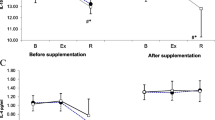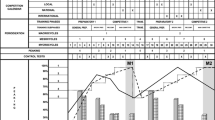Abstract
Our aim was to evaluate the chronic effects of training and competition during a 4-month season on immune response in professional volleyball players. Players took part in an incremental maximal cycling test at the beginning and at the end of the season. As control group, subjects with regular recreational activity were selected. Blood samples were obtained at rest, immediately after the exercise test, and after 30 min recovery. Volleyball players have similar basal levels of erythrocytes, hematocrit, hemoglobin, and total protein and urate than controls and higher levels of creatinine and activities of AST, ALT, and GGT. Maximal incremental exercise test significantly increased erythrocyte counts, hematocrit, and blood hemoglobin levels in volleyball players. T- and B-lymphocytes significantly increased after exercise test and were maintained high during recovery. Cortisol levels were significantly increased immediately after exercise and during recovery with respect to basal values. Basal and post-exercise cortisol levels were significantly higher at the final of season than at the beginning. Serum levels of immunoglobulins (IgG, IgA, and IgM) and complement fractions (C3, C4) were unaffected by the volleyball season. The IgG and IgM levels were significantly higher after exercise and recovery than basal levels. Maximal exercise test induced an acute phase/inflammatory response characterized by increased circulating lymphocytes, antibody response, and cortisol levels. Competition season increases cortisol concentration indicative of accumulated stress intensity.
Similar content being viewed by others
References
Aguilo A, Castano E, Tauler P, Guix MP, Serra N, Pons A (2000) Participation of blood cells in the changes of blood amino acid concentrations during maximal exercise. J Nutr Biochem 11:81–86
Aguilo A, Tauler P, Pilar GM, Villa G, Cordova A, Tur JA, Pons A (2003) Effect of exercise intensity and training on antioxidants and cholesterol profile in cyclists. J Nutr Biochem 14:319–325
Angeli A, Minetto M, Dovio A, Paccotti P, Angeli A, Minetto M, Dovio A, Paccotti P (2004) The overtraining syndrome in athletes: a stress-related disorder. J Endocrinol Investig 27:603–612
Boyum A (1964) Separation of white blood cells. Nature 204:793–794
Córdova A, Álvarez-Mon M (1995) Behaviour of zinc in physical exercise: a special reference to immunity and fatigue. Neurosci Behav Rev 19:439–445
Cordova Martinez A, Escanero JF (1992) Iron, transferrin, and haptoglobin levels after a single bout of exercise in men. Physiol Behav 51:719–722
Cordova A, Martin JF, Reyes E, Alvarez-Mon M (2004) Protection against muscle damage in competitive sports players: the effect of the immunomodulator AM3. J Sports Sci 22:827–833
Engelmann M, Landgraf R, Wotjak CT (2004) The hypothalamic-neurohypophysial system regulates the hypothalamic-pituitary-adrenal axis under stress: an old concept revisited. Front Neuroendocrinol 25:132–149
Gleeson M (2006) Immune system adaptation in elite athletes. Curr Opin Clin Nutr Metab Care 9:659–665
Halson SL, Jeukendrup AE (2004) Does overtraining exist? An analysis of overreaching and overtraining research. Sports Med 34:967–981
Hoffman-Goetz L, Pedersen BK (1994) Exercise and the immune system: a model of the stress response? Immunol Today 15:382–387
Karacabey K, Saygin O, Ozmerdivenli R, Zorba E, Godekmerdan A, Bulut V (2005) The effects of exercise on the immune system and stress hormones in sportswomen. Neuro Endocrinol Lett 26:361–366
Keats D, Cameron K, Morton AR (1988) Exercise and the immune response. Sports Med 5:248–267
Kraemer WJ, Ratamess NA (2005) Hormonal responses and adaptations to resistance exercise and training. Sports Med 35:339–361
Kuipers H, Keizer HA (1988) Overtraining in elite athletes. Review and directions for the future. Sports Med 6:79–92
Mackinnon LT (1996) Immunoglobulin, antibody, and exercise. Exerc Immunol Rev 2:1–35
Mckune AJ, Smith LL, Semple SJ, Wadee AA (2005) Influence of ultra-endurance exercise on immunoglobulin isotypes and subclasses. Br J Sports Med 39(9):665–670
Mckune AJ, Smith LL, Semple SJ, Wadee AA, Fickl H, Villa JG, Gómez-Gallego F, San Juan AF, Lucia A (2006) Changes in mucosal and humoral atopic-related markers and immunoglobulins in elite cyclists participating in the Vuelta a España. Int J Sports Med 27:560–566
Nieman DC, Nehlsen-Cannarella SL (1991) The effects of acute and chronic exercise on immunoglobulins. Sports Med 11:183–201
Nieman DC, Miller AR, Henson DA, Warren BJ, Gusewitch G, Johnson RL, Davis JM, Butterworth DE, Nehlsen-Cannarella SL (1993) Effects of high- vs moderate-intensity exercise on natural killer cell activity. Med Sci Sports Exerc 25:1126–1134
Ostrowski K, Schjerling P, Pedersen BK (2000) Physical activity and plasma interleukin-6 in humans—effect of intensity of exercise. Eur J Appl Physiol 83:512–515
Pedersen BK, Hoffman-Goetz L (2000) Exercise and the immune system: regulation, integration, and adaptation. Physiol Rev 80:1055–1081
Petibois C, Cazorla G, Deleris G (2003) The biological and metabolic adaptations to 12 months training in elite rowers. Int J Sports Med 24:36–42
Sahu A, Lambris JD (2001) Structure and biology of complement protein C3, a connecting link between innate and acquired immunity. Immunol Rev 180:35–48
Smith JA, Kolbuch-Braddon M, Gillam I, Telford RD, Weidemann MJ (1995) Changes in the susceptibility of red blood cells to oxidative and osmotic stress following submaximal exercise. Eur J Appl Physiol Occup Physiol 70:427–436
Sureda A, Ferrer MD, Tauler P, Maestre I, Aguilo A, Cordova A, Tur JA, Roche E, Pons A (2007) Intense physical activity enhances neutrophil antioxidant enzyme gene expression. Immunocytochemistry evidence for catalase secretion. Free Radic Res 41:874–883
Tauler P, Ferrer MD, Sureda A, Aguilo A, Tur JA, Pons A (2008) Antioxidant response and oxidative damage induced by a swimming session: influence of gender. J Sports Sci 26(12):1303–1311
Tvede N, Kappel M, Halkjaer-Kristensen J, Galbo H, Pedersen BK (1993) The effect of light, moderate and severe bicycle exercise on lymphocyte subsets, natural and lymphokine activated killer cells, lymphocyte proliferative response and interleukin 2 production. Int J Sports Med 14:275–282
Viru A (1992) Plasma hormones and physical exercise. Int J Sports Med 13:201–209
Acknowledgments
This work was granted by the Spanish Ministry of Science and Education (Projects DEP2005-00238-CO4-01 and DEP2005-00238-CO4-02/EQUI).
Author information
Authors and Affiliations
Corresponding author
Rights and permissions
About this article
Cite this article
Córdova, A., Sureda, A., Tur, J.A. et al. Immune response to exercise in elite sportsmen during the competitive season. J Physiol Biochem 66, 1–6 (2010). https://doi.org/10.1007/s13105-010-0001-2
Received:
Accepted:
Published:
Issue Date:
DOI: https://doi.org/10.1007/s13105-010-0001-2




